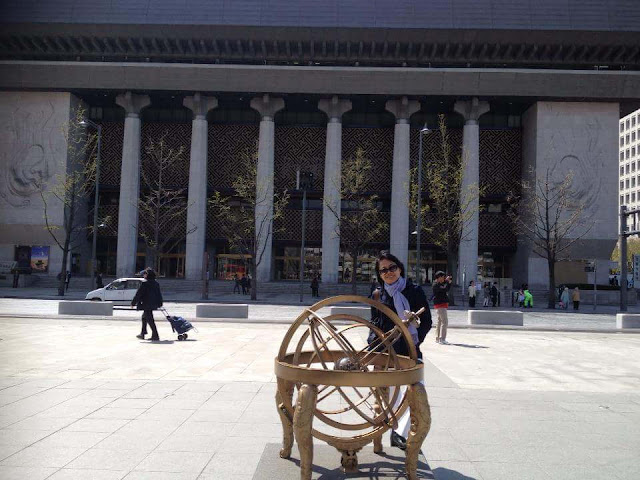Anyeonghaseyo again! Here is another destination you might want to check out when you're traveling to Seoul anytime soon. I am referring to Gwanghamun Square.
Gwanghamun Square is a public are located in the heart of Seoul that features statues, museums, restaurants and surrounding beautiful views. And of course, anyone going to Seoul would not miss visiting this place at all.
So let me show you the different things we saw, the places we took pictures of, and the things we learned.
At the northern end of Gwanghamun Square is the Gwanghamun gate of Gyeongbokgung Palace and Mt. Bugaksan in the background, and on the southern side is the Cheonggye Plaza, where Cheonggyegyeon Stream can be found.
The whole square measures 20,000 square meters and was first opened to the public in 2009.

This is the statue of King Sejong the Great. He was the fourth king of the Joseon Dynasty, and he is beloved and revered by all Koreans because of his great accomplishments and his love for his people. The thing beside me is the sundial, one of King Sejong's inventions.
His most notable achievement was the formation of the Korean alphabet, commonly known as hangeul. Before that time, Koreans used cumbersome systems using Chinese characters for their pronunciation but the differences were so great. Besides, the complexity of the Chinese characters made the writing system too difficult for the common citizens.
He wanted his subjects to be able to express their thoughts freely not just verbally but also by writing. With this objective in mind, he commissioned a group of scholars to devise a phonetic writing system that would correctly represent the sounds of spoken Korean which could easily be learned by everyone, and not just a select few. The system was completed in the year 1443.

The other statue we can see in Gwanghamun Square is that of General Yi Sun Shin. He was a naval commander, who despite not having prior naval training, defeated the Japanese navy during the Imjin war during the Joseon Dynasty. His exploits are well documented, and these two heroes of Korean history are honored in Gwanghamun Square.

The reign of King Sejong the Great was considered the Golden Age of Korea due to many of his accomplishments that made the lives of his subjects better. I am standing beside the celestial globe, another one of King Sejong's inventions, which was used for astronomical or astrological calculations.

My sister donned a costume for kings, ha ha ha. I don't like dressing up so I just took her picture. It was for free so she and her husband put on costumes and I took pictures of them.

These columns with gold carvings are here to depict his great accomplishments during his reign. In the distance we see the Gwanghamun Gate, which is the main entrance of Gyeongbokgung Palace, and Mount Bugak, or Bugaksan in the background.

Underneath Gwanghamun Square is a small museum that tells the story of King Sejong the Great. While looking around Gwanghamun Square, we were curious and looked at every single thing we saw. And we found out that there was a stairway and an elevator going down, so we did, and we found this center.

When you get down to the basement, this is what you see first. Entrance is free so one can just go and learn more about the history of Korea through the King's accomplishments.
These are musical instruments called gayageum. It is a traditional zither-like musical instrument with strings, and it is probably the best known traditional Korean musical instrument. We see these being played in historical dramas when there are special events.
This is the Angbuilgu Sundial, also referred to as the Hemispheric Sundial, which is an important and widely used astronomical scientific device used to tell time. It was invented in 1434 during the 16th year of the reign of King Sejong.
It got its name, Angbuilgu, from the pot shaped design. It literally means “upward looking kettle that catches the shadow of the sun.” Sundials were considered the first public time systems in Korea.
Not sure what this is but it appears to be another musical instrument of some kind. There were a lot of things on display in the museum but I did not take a photo of everything.
This is a replica of a throne, and the good thing about these exhibitions is that they are free of charge and taking pictures is not prohibited. Sharing photos of them through various means is actually a kind of promotional activity, hence, more people get to know about them, and thus, more visitors.
This is another picture with the sundial but showing the constellations and stars that it reflects to tell the time. These indeed were amazing inventions during that period of time.
If you are planning to visit and you take the subway, there are three options for you: take the subway line 3, get off at Gyeongbokgung Station and take exit 6. The other one is subway line 5, get off at Gwanghamun Station, and take exit 2. The third option is the subway line 1, get off at Jonggak Station, and take exit 1.
There are so many places to explore in Seoul if you have time to walk around and explore. We definitely enjoyed our time there and would definitely go back to play 'tour guide'









Comments
Post a Comment